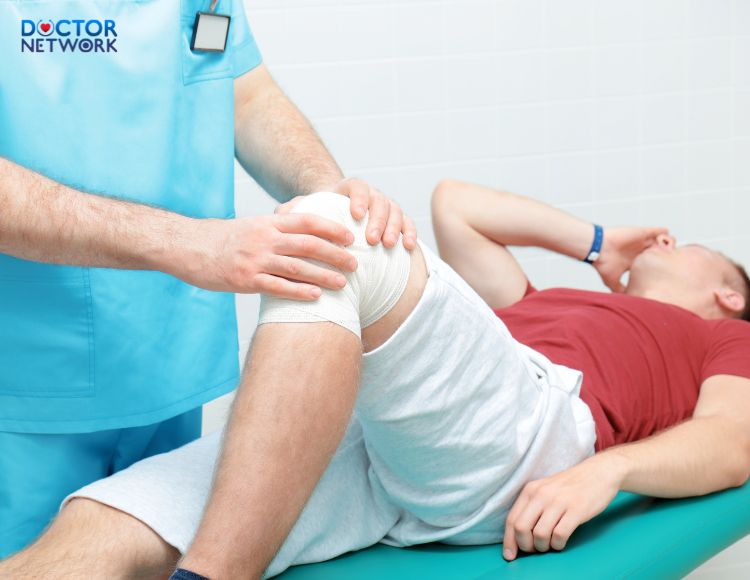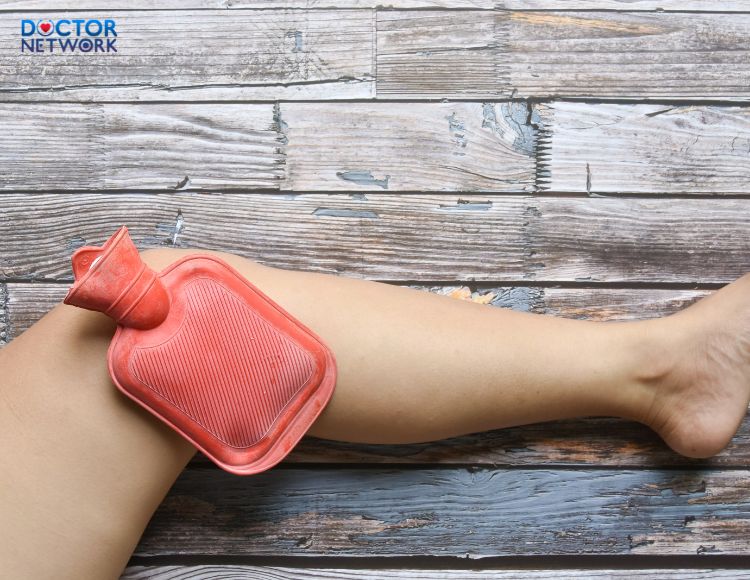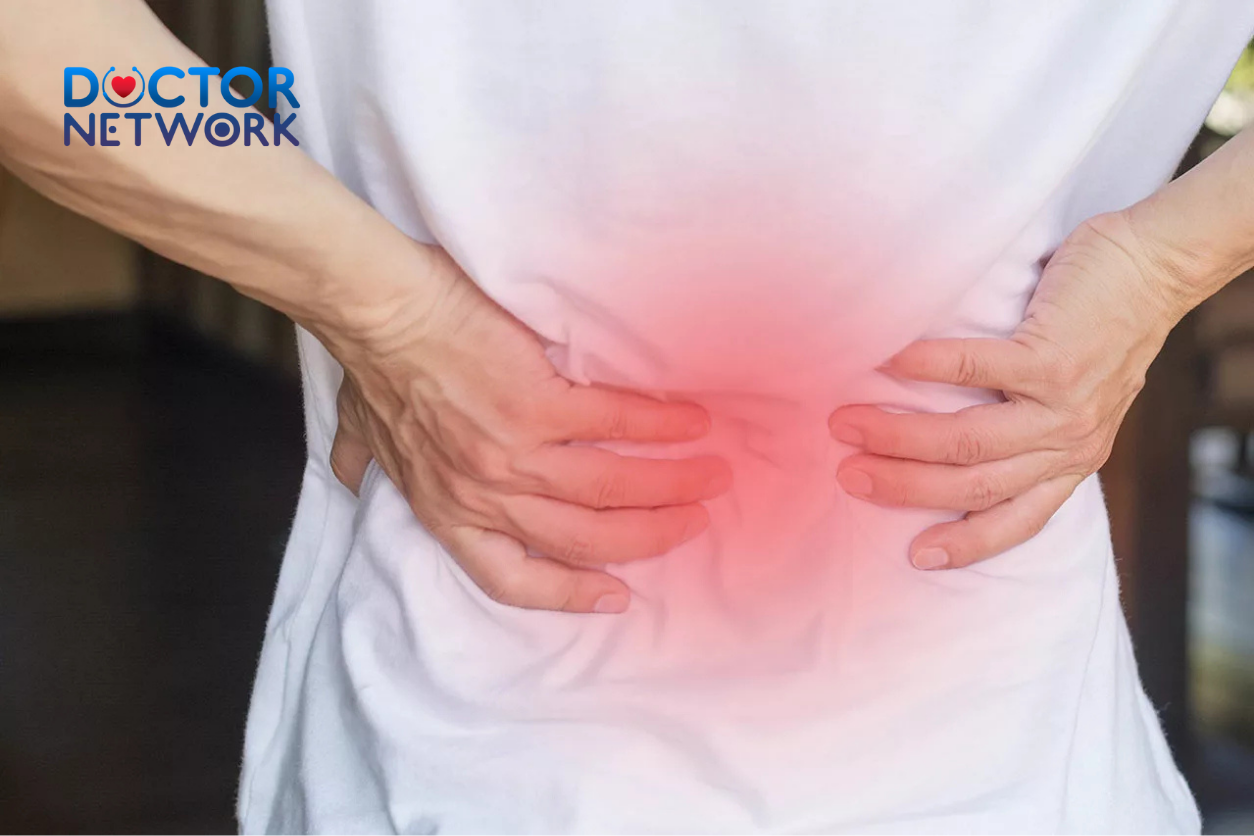Knee ligament sprain is a common injury, especially in sports activities. This condition occurs when the tough fibrous bands connecting the bones around the knee joint (ligaments) are stretched too much or torn. While it’s important to seek medical evaluation to assess the extent of the injury, there are some safe and effective home remedies for knee ligament sprains to reduce symptoms and support the recovery process.
Home Remedies for Knee Ligament Sprains
Below are detailed instructions on treating knee ligament sprains at home, categorized by each stage:
- Acute Stage (First 48-72 hours):
- Rest: Limit movement, use crutches if necessary to reduce pressure on the knee joint.
- Cold Compress: Apply a cold pack or ice wrapped in a towel to the knee area for 15-20 minutes at a time, several times a day.
- Compression: Use an elastic bandage to wrap around the knee at a moderate level to reduce swelling.
- Elevation: When lying down or sitting, elevate the injured leg higher than the level of the heart.
- Pain Relief Medication: Use over-the-counter pain relievers like ibuprofen or acetaminophen to reduce pain and discomfort.

Use a medical elastic bandage to wrap around the knee at a moderate level to reduce swelling
- Recovery Stage (After 48-72 hours):
Physical Therapy: Engage in rehabilitation exercises guided by a doctor or physical therapist to improve knee joint function and strength. Massage: Gently massage the muscles around the knee to increase blood circulation and reduce stiffness. Knee Brace: Use a knee brace as directed by a doctor to provide support and protect the joint.
Post-Acute Care and Recovery
Once pain and swelling have subsided (usually after a few days), you can begin promoting the recovery process:
- Gentle Massage: Continue gentle massage around the knee area to enhance blood flow and reduce stiffness.
- Avoid direct pressure on the injured site. Functional Rehabilitation Exercises: Your doctor or physical therapist will guide you through appropriate exercises to regain mobility and strength for the knee joint. Some simple knee ligament stretching exercises can be done at home.
- Knee Brace: In some cases, using a knee brace can help stabilize and protect the joint, reducing the risk of re-injury. Alternative Therapies for Knee Ligament Treatment
- Some herbal remedies are believed to have pain-relieving properties and support recovery after knee ligament sprains.
- Wormwood: Wormwood has anti-inflammatory and pain-relieving properties in traditional medicine. You can crush wormwood with a little salt and apply the mixture to the sore knee area (avoid applying to open wounds).
- Other Herbs: Some other folk remedies for knee ligament sprains use aloe vera, betel leaves, etc. However, the effectiveness of these herbs requires further research, so caution is advised when applying them.
Nutrition and Lifestyle
- Foods to Eat: To promote healing, supplement your diet with protein-rich foods (meat, fish, eggs, legumes), vitamin C (citrus fruits, guava, kiwi, broccoli), calcium (milk, yogurt, cheese).
- Limit Certain Foods: Avoid processed foods, high-fat foods, and alcoholic beverages.
- Sleep: Aim for adequate sleep.
- Stress Management: Because stress can slow down the healing process, practice stress-reducing techniques like meditation, deep breathing, or yoga.
When to See a Doctor?
Most cases of mild knee ligament sprains can be improved with home care. However, you should see a doctor immediately if:
- Severe pain, unable to bear weight on the injured leg
- Significant swelling and bruising around the knee
- Numbness or tingling sensation in the leg area
- Audible popping sound or feeling of knee joint instability
- Symptoms do not improve after a period of home treatment
In severe cases, the doctor may recommend more advanced treatment methods such as physical therapy or surgery to restore knee ligament function.
Home Remedies for Knee Ligament Sprains can reduce pain, swelling, and accelerate the recovery process. However, it’s essential to always consult a doctor to diagnose the extent of the injury and determine the most appropriate treatment plan.
Related Questions about “Home Remedies for Knee Ligament Sprains”
How to differentiate knee ligament sprains from other injuries?
Knee ligament sprains often have typical symptoms such as pain, swelling, stiffness, bruising, and a feeling of instability when moving. Other injuries may also cause similar signs like fractures, dislocations. The best approach is to consult a doctor for an accurate diagnosis through examination and imaging tests (if necessary).
How long should I rest after a knee ligament sprain?
Complete rest time during the acute phase may last 48-72 hours. Afterward, you should start gentle functional recovery exercises to increase blood circulation, avoid joint stiffness, and gradually regain mobility. Listen to your body and always consult your doctor or physical therapist to develop an appropriate exercise schedule.
Is it advisable to apply heat for knee ligament sprains?
During the acute phase (approximately the first 3 days after injury), prioritize cold compresses to reduce inflammation and swelling. Heat therapy can be applied afterward to enhance blood circulation. However, always consult your doctor before applying any heat therapy methods.

Hot compresses can be applied afterwards to enhance blood circulation
Should I return to vigorous activity as before after a knee ligament sprain?
Returning to high-intensity activities requires a gradual rehabilitation process under the guidance of a physical therapist. Starting intense activity too early poses a high risk of re-injury. The key is to build a solid foundation of knee joint strength and mobility before challenging limits.
How long does it take to fully recover from a knee ligament sprain?
Recovery time after a knee ligament sprain depends on the severity of the injury and the treatment process. Mild cases may improve within a few weeks, while more severe cases may take several months. The important thing is to persevere with the treatment and recovery process correctly.
Scientific Evidence
Cold Compress:
Effectiveness: Reduces pain, swelling, inflammation. Application: Apply cold compress for 15-20 minutes each time, several times a day within the first 48-72 hours after injury. References:
- The efficacy of cold compress in the treatment of acute ankle sprains: A systematic review and meta-analysis: https://www.ncbi.nlm.nih.gov/pmc/articles/PMC5548824/
- Cold compress therapy in musculoskeletal injury treatment: https://www.ncbi.nlm.nih.gov/pmc/articles/PMC4434004/
Rest:
Effectiveness: Limits movement, reduces pressure on the knee joint, facilitates the recovery process. Application: Limit strenuous activity, use crutches if necessary within the first 48-72 hours after injury. References:
- Rest is the best way to heal an injury
- The role of rest in recovery from injury: https://www.ncbi.nlm.nih.gov/pmc/articles/PMC4434004/
The article has provided information on “home remedies for knee ligament sprains” and related knowledge. Hopefully, the article will be helpful to you.
Kiểm Duyệt Nội Dung
More than 10 years of marketing communications experience in the medical and health field.
Successfully deployed marketing communication activities, content development and social networking channels for hospital partners, clinics, doctors and medical professionals across the country.
More than 6 years of experience in organizing and producing leading prestigious medical programs in Vietnam, in collaboration with Ho Chi Minh City Television (HTV). Typical programs include Nhật Ký Blouse Trắng, Bác Sĩ Nói Gì, Alo Bác Sĩ Nghe, Nhật Ký Hạnh Phúc, Vui Khỏe Cùng Con, Bác Sỹ Mẹ, v.v.
Comprehensive cooperation with hundreds of hospitals and clinics, thousands of doctors and medical experts to join hands in building a medical content and service platform on the Doctor Network application.

























